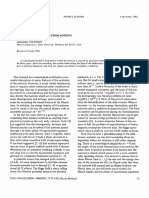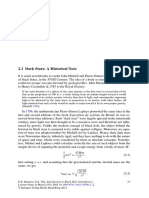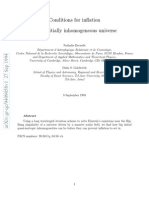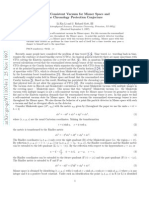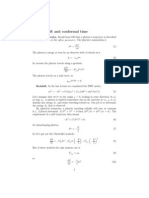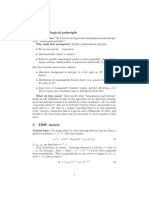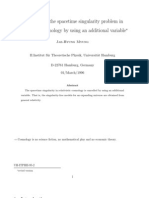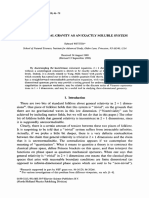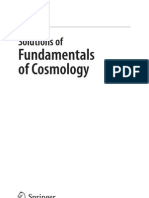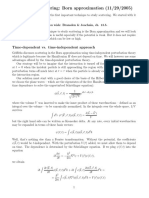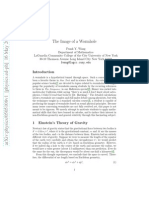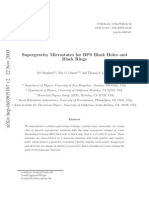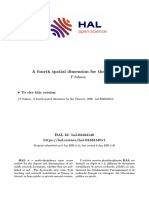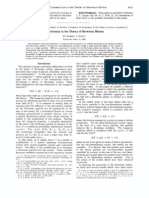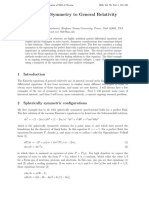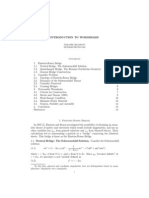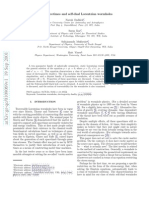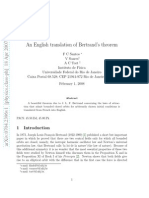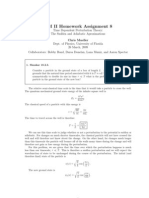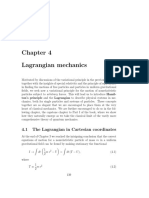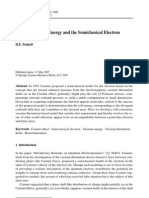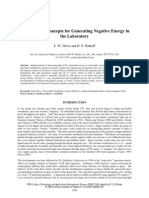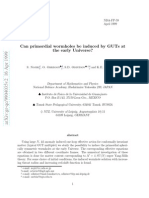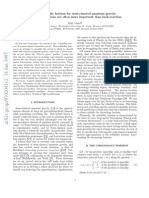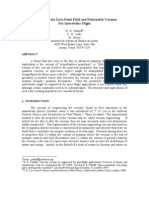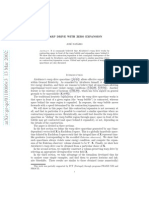Li-Xin Li - Two Open Universes Connected by A Wormhole: Exact Solutions
Li-Xin Li - Two Open Universes Connected by A Wormhole: Exact Solutions
Uploaded by
RtpomCopyright:
Available Formats
Li-Xin Li - Two Open Universes Connected by A Wormhole: Exact Solutions
Li-Xin Li - Two Open Universes Connected by A Wormhole: Exact Solutions
Uploaded by
RtpomOriginal Title
Copyright
Available Formats
Share this document
Did you find this document useful?
Is this content inappropriate?
Copyright:
Available Formats
Li-Xin Li - Two Open Universes Connected by A Wormhole: Exact Solutions
Li-Xin Li - Two Open Universes Connected by A Wormhole: Exact Solutions
Uploaded by
RtpomCopyright:
Available Formats
a
r
X
i
v
:
h
e
p
-
t
h
/
0
1
0
2
1
4
3
v
1
2
1
F
e
b
2
0
0
1
Two Open Universes Connected by a Wormhole:
Exact Solutions
Li-Xin Li
Department of Astrophysical Sciences, Princeton University
Princeton, NJ 08544, USA
September 28, 2000
Abstract
In this paper I present a spacetime of two open universes connected by a Lorentzian
wormhole. The spacetime has the following features: (1) It can exactly solve the
Einstein equations; (2) The weak energy condition is satised everywhere; (3) It has a
topology of R
2
T
g
(g 2); (4) It has no event horizons.
Key words: topology, wormhole, cosmology
1
Wormholes (or quantum foams) could play important roles on both microscopic and
macroscopic scales in the realm of classical and quantum gravity [1, 2, 3, 4]. Field lines
trapped in wormholes have led to the concepts of mass without mass and charge without
charge [1, 2]. In the context of Euclidean quantum gravity, Euclidean wormholes arise from
topology change on the Planckian scales, which have been proposed to cause the loss of
quantum coherence or to x coupling constants [3, 4]. (However, see the recent discussions
of Hawking [5].) More interestingly, Morris, Thorne, and Yurtsever [6] (see also Novikov
[7]) have shown that a Lorentzian wormhole can be transformed into a time machine (i.e.,
a spacetime with closed timelike curves). Morris and Thorne [8] have also considered the
possibility of using Lorentzian wormholes as tools for interstellar travel. Applications of
wormholes in cosmology have also been investigated [9, 10].
In this paper I focus on Lorentzian wormholes, which are essentially the time-development
of three-dimensional wormholes [11, 12]. Such kind of spacetimes exhibit wormhole structures
on their spacelike foliations, the wormholes either connect one universe to another universe
or connect one region to another distant region in the same universe. As far as I am aware, al-
most all of the Lorentzian wormhole solutions discovered in literatures have two-dimensional
spacelike cross-sections with a topology of S
2
. With very generic arguments, Morris and
Thorne [8] have shown that for static, spherically symmetric, and traversable (i.e., having no
event horizons) wormholes the weak energy condition must be violated near the wormhole
throats. Dynamic (evolving) wormholes have also been considered [13, 14, 15, 16, 17, 18].
It has been demonstrated that dynamic wormholes without violation of the weak energy
condition could exist within a nite period of time [13, 14]. In this paper, I present a worm-
hole spacetime whose two-dimensional spacelike cross-sections have a topology of T
g
(g 2)
instead of S
2
that is usually considered in literatures, where T
g
is a g-torus. I show that,
the wormhole spacetime represents two open universes connected by a Lorentzian wormhole
and has the following features: (1) It can exactly solve the Einstein equations; (2) The weak
energy condition is satised everywhere; (3) It has a topology of R
2
T
g
(g 2); (4) It has
no event horizons.
The wormhole spacetime is constructed from a usual open Friedmann-Robertson-Walker
(FRW) universe. An open FRW universe has negative spatial curvature and can be foliated
2
with spatial hyperbolic hypersurfaces (H
3
). Each H
3
can be embedded in a four-dimensional
Minkowski spacetime through [19]
T
2
X
2
Y
2
Z
2
= a
2
, (1)
where (T, X, Y, Z) are the Cartesian coordinates in the Minkowski spacetime, a is a constant.
(Throughout the paper I use the geometric units G = c = 1.) The metric of the Minkowski
spacetime is
dS
2
= dT
2
+ dX
2
+ dY
2
+ dZ
2
. (2)
Dierent H
3
can have a dierent radius, thus a is a function of the cosmic time t which
labels the spacelike foliation of the universe. Lets cut an H
3
at Z = constant, then we
obtain a two-dimensional hyperbolic surface H
2
with a radius (a
2
+ Z
2
)
1/2
. An H
2
is a
two-dimensional Lobachevskii space, which can be compactied through H
2
/, where is
an isometric group without xed points on H
2
. If we require manifolds to be orientable, then
the only compact surfaces that can be obtained from H
2
are g-tori T
g
with g 2 being the
genus (i.e., the number of holes) of the surfaces [20, 21, 22]. A T
g
with g 1 can be obtained
as the quotient of a polygon of 4g sides with all vertices being identied with each other
and the sides being identied in pairs [21]. Now lets start with an open FRW universe and
compactify its two-dimensional cross-section H
2
to a T
g
(g 2), then we obtain a spacetime
(M, g
ab
) which has the same metric as an ordinary open FRW universe but has a topology of
M = R
2
T
g
(g 2). [An ordinary open FRW universe, i.e. the covering space of (M, g
ab
),
has a topology of R H
3
.] I will show that the spacetime (M, g
ab
) represents two open
universes connected by an evolving Lorentzian wormhole.
The spacetime (M, g
ab
) can be covered locally with coordinates (t, , , ), where t is the
cosmic time and (, , ) are dened with (T, X, Y, Z) through
T = a cosh cosh , (3)
X = a cosh sinh cos , (4)
Y = a cosh sinh sin , (5)
Z = a sinh . (6)
3
Then the FRW metric is given by
ds
2
= dt
2
+ a(t)
2
_
d
2
+ cosh
2
_
d
2
+ sinh
2
d
2
__
. (7)
Consider the two-dimensional cross-section S = T
g
(g 2) with t = constant and =
constant. The metric on S is
ds
2
= a
2
cosh
2
_
d
2
+ sinh
2
d
2
_
. (8)
According to the Gauss-Bonnet theorem, the area of S is [21, 23]
A = 4(g 1)a
2
cosh
2
. (9)
Thus, the size of S is completely determined by its genus and the metric on it. On the
hypersurface t = constant, A takes the minimum at = 0: A
min
= 4(g 1)a
2
which is non-
zero for g 2. As , A exponentially and we enter two open universes (they
are open since the hypersurface t = constant has uniform negative curvature everywhere).
Therefore, (M, g
ab
) represents a spacetime of two open universes connected by a wormhole.
One open universe is on the side with > 0, the other is on the side with < 0. The
throat of the wormhole is at = 0. Since a = a(t), the wormhole evolves with time.
The coordinate measures the proper distance from the wormholes throat on the hy-
persurface t = constant, which goes from to . Dene r = cosh , then the metric in
Eq. (7) can be written as
ds
2
= dt
2
+ a(t)
2
_
dr
2
r
2
1
+ r
2
_
d
2
+ sinh
2
d
2
_
_
. (10)
However, r > 1 covers only one side of the wormhole: either the region with > 0, or the
region with < 0.
Since (M, g
ab
) is locally isometric to an open FRW universe, it can exactly solve the
Einstein equations with a suitable stress-energy tensor. Lets take the stress-energy tensor
to be that of a perfect uid: T
ab
= (+p)u
a
u
b
+pg
ab
, where u
a
= (/t)
a
is the four-velocity
of comoving observers, = (t) and p = p(t) are the energy density and pressure measured
by comoving observers. Then for the metric in Eq. (7) the Einstein equations are reduced
to the familiar forms for an open FRW universe
_
a
a
_
2
=
8
3
+
1
a
2
+
3
, (11)
a
a
=
4
3
( + 3p) +
3
, (12)
4
where the dot denotes d/dt, is the cosmological constant. Supplied with a state equation
p = p(), Eq. (11) and Eq. (12) can be solved. There are many exact solutions, here I list
some of them [24]:
1) Vacuum solution: Let = p = = 0, then we have the simplest solution
a = t, (13)
which is locally a Milne universe.
2) Wormhole supported by dust: In such a case p = 0, = 0, and a
3
= constant 3C
1
/8.
The solutions are
a =
1
2
C
1
(cosh 1) , t =
1
2
C
1
(sinh ) , (14)
where > 0 is a parameter.
3) Wormhole supported by radiation: In such a case p = /3, = 0, and a
4
= constant
3C
2
/8. The solutions are
a =
_
t
2
+ 2C
1/2
2
t
_
1/2
. (15)
4) Wormhole supported by a cosmological constant: Suppose > 0 and = p = 0. Then we
have the open de Sitter solutions
a =
_
3
_
1/2
sinh
_
_
3
_
1/2
t
_
. (16)
These are inating wormholes.
Since all these wormhole solutions are supported by ordinary matter (dust, radiation,
or simply vacuum) or a positive cosmological constant, the weak energy condition (which
requires 0 and + p 0) is satised throughout the wormhole spacetime. In fact,
for the solutions in 1) 2) and 3), all energy conditions (the weak energy condition, the null
energy condition, the dominant energy condition, the strong energy condition, etc [12, 19])
are satised all the time and everywhere.
All the solutions presented above are dynamic. If we let a = a = 0 in Eq. (11) and
Eq. (12), we get +p = (4a
2
)
1
< 0, so there are no static solutions satisfying the weak
energy condition.
5
Since the weak energy condition is satised and the spatial curvature is negative, the
wormhole spacetime constructed above expands forever if it expands initially. Such a worm-
hole spacetime has no event horizons and no singularities in the future, so an observer can
travel from one side to the other if he travels to the future. Though the spacetime may
have singularities in the past as in the big-bang case, there will be no problem if a time
arrow exists as in our universe. The time arrow will forbid any observer and light ray from
traveling to the past, then we only need to consider traveling to the future. [The solutions
in 1) and 4) even do not have singularities in the past, any worldline in these solutions can
be extended to the past innitely.] In such a wormhole spacetime with a time arrow, an
observer can travel from one side to the other. The observer will feel no tidal force since
the space is homogeneous. In fact he will not feel any dierence in local spatial geometry
from the place where he starts. If 0 and 0 as in the cases for our solutions,
the observer even will not feel the existence of the throat, since the wormhole expands so
rapidly that as the observer passes through the wormhole to the other side he always sees
that the cross-section S gets larger and larger. To see this, lets consider a bunch of light
rays passing through the wormhole. Suppose the light rays travel in such a way that at any
moment their velocity is perpendicular to S, i.e., along every light ray we have = constant
and = constant. (This can be realized due to the symmetry of the spacetime.) Lets take
the tangent vector of the null geodesics of the light rays to be
k
a
=
1
a
__
t
_
a
+
1
a
_
_
a
_
. (17)
It can be checked that k
a
satises the ane geodetic equation k
b
b
k
a
= 0, so is the ane
parameter of the null geodesics if k
a
= (/)
a
. Further more, it can be shown that
=
_
adt . (18)
The light rays form a null geodetic congruence orthogonal to S. The expansion of the
light rays,
a
k
a
, is related to the variation of A (the area of S) along the light rays by
d lnA/d =
a
k
a
[11]. So we have
d lnA
d
=
2
a
2
(tanh + a) . (19)
Eq. (19) can also be obtained from Eq. (9) and Eq. (18) by using the fact that d = dt/a
along the light rays. From Eq. (11), if and are non-negative, a
2
1 always. If a > 0
6
which is true for the expanding solutions described above, we always have a 1. Since
tanh > 1, we have tanh + a > 0 all the time. So, along the light rays, d ln A/d is
always positive. This must also be true for the observer since he can never travel faster
than light: as the observer travels through the wormhole, he will see that the size of S keeps
increasing.
Hochberg and Visser have demonstrated that violation of the null energy condition is a
generic feature of all wormholes, no matter they are static or dynamic [25, 26]. (The null
energy condition requires only +p 0, so the weak energy condition implies the null energy
condition. In other words, if the null energy condition is violated the weak energy condition
must be violated too.) Their arguments essentially rely on their denition of wormhole
throats and their assumption that all wormholes have throats with their denition. They
dene a wormhole throat to be a marginally anti-trapped surface, which means that bundles
of light rays that enter the wormhole at one mouth and emerge from the other must have
cross-sectional areas that initially decrease and then increase [25, 8]. With this denition
of throats, the wormhole spacetime constructed in this paper does not have a throat if
and are non-negative, since bundles of light rays propagating through it always diverge.
However, the spacetime I have constructed exhibits a well-dened wormhole structure with
a well-dened throat (with the ordinary meaning [6, 8]) on the spatial hypersurface at any
moment: two large spaces are connected by a narrow tube. My results do not conict with
the claim of Hochberg and Visser because their denition of wormhole throats does not apply
to my case. This means that Hochberg and Vissers denition of wormhole throats cannot
cover all kinds of wormhole spacetimes, there exist spacetimes which have unambiguous
wormhole structures but do not have throats with Hochberg and Vissers denition. (A
classical example of wormhole that cannot be covered by Hochberg and Vissers denition
is the Einstein-Rosen bridge [27]. As bundles of light rays pass through the Einstein-Rosen
bridge from one side, their cross-sectional areas keep decreasing until the light rays hit the
future spacetime singularity.)
In summary, I have constructed a wormhole spacetime which has many nice features.
The spacetime represents two open universes connected by a wormhole. Since more and
more observations show that we are living in a universe with a low mass density, it is
7
quite possible that our universe is open ([28, 29] and the references therein; certainly there is
another possibility that we are living in a at universe with a positive cosmological constant).
Maybe one of the open universes in the wormhole spacetime I have constructed is just the
universe that we are living in, at least there is no observational evidence to exclude this
possibility! It would be interesting to investigate the uctuations of the cosmic microwave
background in such a wormhole spacetime to see if it is possible to tell if we are really living
in such an open universe [30, 31]. The wormhole spacetime can exactly solve the Einstein
equations with a stress-energy tensor satisfying the weak energy condition. The solutions
presented in the paper are true solutions to the Einstein equations since we are aware of the
matter contents required by these solutions, which are dust, radiation, vacuum, or a positive
cosmological constant. In contrast, for most wormhole solutions in literatures (the Einstein-
Rosen bridge is a prominent exception), a geometry is assumed and the stress-energy tensor
is calculated from the metric by solving the Einstein equations reversely.
I am grateful to J. Richard Gott for helpful discussions. This work was supported by the
NSF grant AST-9529120.
References
[1] J. A. Wheeler, Geons, Phys. Rev. 97 (1955) 511-536.
[2] C. W. Misner and J. A. Wheeler, Classical physics as geometry: Gravitation, elec-
tromagnetism, unquantized charge, and mass as properties of curved empty space,
Ann. Phys. (N. Y.) 2 (1957) 525-603.
[3] S. W. Hawking, Wormholes in spacetime, Phys. Rev. D 37 (1988) 904-910.
[4] S. B. Giddings and A. Strominger, Axion-induced topology change in quantum
gravity and string theory, Nucl. Phys. B306 (1998) 890-907.
[5] S. W. Hawking, Virtual black holes, Phys. Rev. D 53 (1996) 3099-3107.
[6] M. S. Morris, K. S. Thorne, and U. Yurtsever, Wormholes, time machines, and the
weak energy condition, Phys. Rev. Lett. 61 (1988) 1446-1449.
8
[7] V. P. Frolov and I. D. Novikov, Physical eects in wormholes and time machines,
Phys. Rev. D 42 (1990) 1057-1065.
[8] M. S. Morris and K. S. Thorne, Wormholes in spacetime and their use for interstellar
travel: A tool for teaching general relativity, Am. J. Phys. 56 (1988) 395-412.
[9] D. Hochberg and T. W. Kephart, Wormhole cosmology and the horizon problem,
Phys. Rev. Lett. 70 (1993) 2665-2668.
[10] L. Liu, F. Zhao, and L. -X. Li, Can the vacuum foam structure solve the atness
problem of a big bang universe? Phys. Rev. D 52 (1995) 4752-4753.
[11] C. W. Misner, K. S. Thorne, and J. A. Wheeler, Gravitation, W. H. Freeman and
Company, San Francisco, 1973.
[12] M. Visser, Lorentzian Wormholes: from Einstein to Hawking, AIP Press, New York,
1995.
[13] S. Kar, Evolving wormholes and the weak energy condition, Phys. Rev. D 49 (1994)
862-865.
[14] S. Kar and D. Sahdev, Evolving Lorentzian wormholes, Phys. Rev. D. 53 (1996)
722-730.
[15] T. A. Roman, Inating Lorentzian wormholes, Phys. Rev. D 47 (1993) 1370-1379.
[16] T. A. Roman, The inating wormhole: a mathematica animation, Comput. Phys.
8 (1994) 480-487.
[17] A. Wang and P. S. Letelier, Dynamical wormholes and energy conditions, Prog.
Theor. Phys. 94 (1995) 137-142.
[18] L. A. Anchordoqui, D. F. Torres, M. L. Trobo, and S. E. Perez Begliaa, Evolving
wormhole geometries, Phys. Rev. D 57 (1998) 829-833.
[19] S. W. Hawking and G. F. R. Ellis, The Large Scale Structure of Space-Time, Cam-
bridge University Press, Cambridge, 1973.
9
[20] M. Lachi`eze-Rey and J. -P. Luminet, Cosmic topology, Phys. Rep. 254 (1995) 135-
214.
[21] R. Benedetti and C. Petronio, Lectures on Hyperbolic Geometry, Springer-Verlag,
Berlin, 1992.
[22] J. R. Gott, Chaotic cosmologies and the topology of the universe, Mon. Not. R.
Astron. Soc. 193 (1980) 153-169.
[23] I. N. Bernshten and V. F. Shvartsman, On the connection between the size of the
Universe and its curvature, Sov. Phys. JETP 52 (1981) 814-820.
[24] P. J. E. Peebles, Principles of Physical Cosmology, Princeton University Press,
Princeton, 1993.
[25] D. Hochberg and M. Visser, Dynamic wormholes, antitrapped surfaces, and energy
conditions, Phys. Rev. D 58 (1998) 044021.
[26] D. Hochberg and M. Visser, Null energy condition in dynamic wormholes, Phys.
Rev. Lett. 81 (1998) 746-749.
[27] A. Einstein and N. Rosen, The particle problem in the general theory of relativity,
Phys. Rev. 48 (1935) 73-77.
[28] J. R. Gott, Open, CDM inationary universes, in Critical Dialogues in Cosmology,
edited by N. Turok, World Scientic, Singapore, 1997, pp. 519-534.
[29] J. R. Gott and L. -X. Li, Can the Universe create itself? Phys. Rev. D 58 (1998)
023501.
[30] N. Cornish, D. N. Spergel, and G. Starkman, Circles in the sky: nding topology
with the microwave background radiation, Class. Quant. Grav. 15 (1998) 2657-2670.
[31] N. Cornish and D. N. Spergel, A small universe after all? Phys. Rev. D 62 (2000)
087304.
10
You might also like
- Creation of Universes From NothingDocument4 pagesCreation of Universes From NothingOmar MohammedNo ratings yet
- Particle CosmologyDocument39 pagesParticle CosmologyCroco AliNo ratings yet
- A New Understanding of Particles by G - Flow Interpretation of Differential EquationDocument10 pagesA New Understanding of Particles by G - Flow Interpretation of Differential EquationDon HassNo ratings yet
- Black Holes: 2.1 Dark Stars: A Historical NoteDocument42 pagesBlack Holes: 2.1 Dark Stars: A Historical NoteJOAQUIN RODRIGUEZ TORONo ratings yet
- Conditions For Inflation in An Initially Inhomogeneous UniverseDocument15 pagesConditions For Inflation in An Initially Inhomogeneous UniverseCaleb NorthNo ratings yet
- E. Ebrahimi and N. Riazi - (N + 1) - Dimensional Lorentzian Wormholes in An Expanding Cosmological BackgroundDocument12 pagesE. Ebrahimi and N. Riazi - (N + 1) - Dimensional Lorentzian Wormholes in An Expanding Cosmological BackgroundCoy668No ratings yet
- M.A. Dariescu Et Al - Thermodynamics of Bosons in An Universe With Global PathologyDocument10 pagesM.A. Dariescu Et Al - Thermodynamics of Bosons in An Universe With Global PathologyAzmerzrNo ratings yet
- Li-Xin Li and J. Richard Gott, III - A Self-Consistent Vacuum For Misner Space and The Chronology Protection ConjectureDocument5 pagesLi-Xin Li and J. Richard Gott, III - A Self-Consistent Vacuum For Misner Space and The Chronology Protection ConjectureRtpomNo ratings yet
- Two Body ProblemDocument25 pagesTwo Body ProblemNathanianNo ratings yet
- Big-Bang CosmologyDocument30 pagesBig-Bang CosmologyVamsi KrishnaNo ratings yet
- Akarsu 2011Document10 pagesAkarsu 2011Rakesh DabgarNo ratings yet
- Massimo Giovannini - Homogeneous and Isotropic Big Rips?Document8 pagesMassimo Giovannini - Homogeneous and Isotropic Big Rips?Dex30KMNo ratings yet
- Hristu Culetu - Light Dragging Phenomenon and Expanding WormholesDocument11 pagesHristu Culetu - Light Dragging Phenomenon and Expanding WormholesCoy668No ratings yet
- 1 Redshift and Conformal TimeDocument10 pages1 Redshift and Conformal Timemaneesh_massey_1No ratings yet
- A Model For The Big Bounce: Theoretical Physics Division, CERN, CH-1211 Geneva 23, SwitzerlandDocument10 pagesA Model For The Big Bounce: Theoretical Physics Division, CERN, CH-1211 Geneva 23, SwitzerlandJohan LópezNo ratings yet
- Friedmann ThesisDocument10 pagesFriedmann ThesisSyed Muhammed Alee KazmiNo ratings yet
- SolutionspacetimesinguDocument10 pagesSolutionspacetimesinguannunaki-1974No ratings yet
- 2 + 1 Dimensional Gravity As An Exactly Soluble System PDFDocument33 pages2 + 1 Dimensional Gravity As An Exactly Soluble System PDFAnonymous rJi74AWkNo ratings yet
- Jose P. S. Lemos and Francisco S. N. Lobo - Plane Symmetric Traversable Wormholes in An Anti-De Sitter BackgroundDocument14 pagesJose P. S. Lemos and Francisco S. N. Lobo - Plane Symmetric Traversable Wormholes in An Anti-De Sitter BackgroundRtpomNo ratings yet
- Lecture 2. Perturbation Theory in General Relativity I: Dmitry PodolskyDocument9 pagesLecture 2. Perturbation Theory in General Relativity I: Dmitry PodolskyFlori Rodriguez HernandezNo ratings yet
- Manual Solution Fundamentals Cosmology RichDocument43 pagesManual Solution Fundamentals Cosmology Richrscaraca100% (1)
- Lecture 19: Scattering: Born Approximation (11/29/2005) : Time-Dependent vs. Time-Independent ApproachDocument6 pagesLecture 19: Scattering: Born Approximation (11/29/2005) : Time-Dependent vs. Time-Independent Approachbgiangre8372No ratings yet
- Frank Y. Wang - The Image of A WormholeDocument7 pagesFrank Y. Wang - The Image of A WormholeKunma050No ratings yet
- Dynamical Symmetry of The Kaluza-Klein MonopoleDocument14 pagesDynamical Symmetry of The Kaluza-Klein MonopoleBayer MitrovicNo ratings yet
- Per Berglund, Eric G. Gimon and Thomas S. Levi - Supergravity Microstates For BPS Black Holes and Black RingsDocument25 pagesPer Berglund, Eric G. Gimon and Thomas S. Levi - Supergravity Microstates For BPS Black Holes and Black RingsHuntsmithNo ratings yet
- Week1 PDFDocument10 pagesWeek1 PDFLodovyco NazaréNo ratings yet
- The Mass of The Oppenheimer Black Hole: Only Finite Mass Quasi Black Holes (Eternally Collapsing Objects'': IJMPD 2013Document18 pagesThe Mass of The Oppenheimer Black Hole: Only Finite Mass Quasi Black Holes (Eternally Collapsing Objects'': IJMPD 2013Dr Abhas MitraNo ratings yet
- Grhw1: 1 D 1 D 1 1 D DDocument8 pagesGrhw1: 1 D 1 D 1 1 D DMatejaBoskovicNo ratings yet
- Lecture Notes On Cosmology (ns-tp430m) by Tomislav Prokopec Part I: An Introduction To The Einstein Theory of GravitationDocument37 pagesLecture Notes On Cosmology (ns-tp430m) by Tomislav Prokopec Part I: An Introduction To The Einstein Theory of GravitationEnzo SoLis GonzalezNo ratings yet
- Fluid Flow Versus Geometric DynamicsDocument13 pagesFluid Flow Versus Geometric DynamicsDragos IsvoranuNo ratings yet
- TOV - StarsDocument8 pagesTOV - StarsAllan GonçalvesNo ratings yet
- Geodesics Using MathematicaDocument24 pagesGeodesics Using MathematicaMizanur RahmanNo ratings yet
- Electron Spin Resonance: Theory and ApplicationsDocument25 pagesElectron Spin Resonance: Theory and ApplicationswexlerNo ratings yet
- Article 2 yDocument11 pagesArticle 2 yrune siqueiraNo ratings yet
- S N 1 T NDocument14 pagesS N 1 T NsatyabashaNo ratings yet
- Lectures On General RelativityDocument63 pagesLectures On General RelativityMichael Anthony MendozaNo ratings yet
- Labeling Spherically Symmetric Spacetimes With The Ricci TensorDocument20 pagesLabeling Spherically Symmetric Spacetimes With The Ricci TensorCroco AliNo ratings yet
- Ashtekar Formulation of 2+1 Gravity On A TorusDocument15 pagesAshtekar Formulation of 2+1 Gravity On A TorusCutelaria SaladiniNo ratings yet
- QSP Examples1Document8 pagesQSP Examples1Utilities CoNo ratings yet
- Einstein Rosen BridgeDocument7 pagesEinstein Rosen BridgearantheoNo ratings yet
- Witten de Sitter CFTDocument20 pagesWitten de Sitter CFTEvanAdamsNo ratings yet
- K. Bronnikov and S. Grinyok - Charged Wormholes With Non-Minimally Coupled Scalar Fields. Existence and StabilityDocument6 pagesK. Bronnikov and S. Grinyok - Charged Wormholes With Non-Minimally Coupled Scalar Fields. Existence and StabilityRtpomNo ratings yet
- Mauricio Cataldo, Patricio Salgado and Paul Minning - Self-Dual Lorentzian Wormholes in N-Dimensional Einstein GravityDocument6 pagesMauricio Cataldo, Patricio Salgado and Paul Minning - Self-Dual Lorentzian Wormholes in N-Dimensional Einstein GravityKunma050No ratings yet
- Contribution To The Theory Brownian MotionDocument4 pagesContribution To The Theory Brownian MotionVicente SamithNo ratings yet
- The Royal SocietyDocument6 pagesThe Royal SocietyIván Francisco Huergo RíosNo ratings yet
- Jose P. Mimoso and Francisco S. N. Lobo - An Anti-Schwarzshild Solution: Wormholes and Scalar-Tensor SolutionsDocument3 pagesJose P. Mimoso and Francisco S. N. Lobo - An Anti-Schwarzshild Solution: Wormholes and Scalar-Tensor SolutionsKunma050No ratings yet
- Masashi Yasunaga and Makoto Tsubota - Rabi-Josephson Transitions in Spinor Bose-Einstein CondensatesDocument6 pagesMasashi Yasunaga and Makoto Tsubota - Rabi-Josephson Transitions in Spinor Bose-Einstein CondensatesPomac232No ratings yet
- Curious Space Time SingularitiesDocument4 pagesCurious Space Time Singularitiesannunaki-1974100% (1)
- HarrisonDocument11 pagesHarrisonSweta AkhoriNo ratings yet
- Energy, Momentum, and Center of Mass inDocument10 pagesEnergy, Momentum, and Center of Mass incruzguille979No ratings yet
- Takashi Okamoto - Introduction To WormholesDocument14 pagesTakashi Okamoto - Introduction To WormholesHerftezNo ratings yet
- Black Holes - TWMposter 12apr09Document12 pagesBlack Holes - TWMposter 12apr09maxwallis100% (2)
- Naresh Dadhich Et Al - R 0 Spacetimes and Self-Dual Lorentzian WormholesDocument8 pagesNaresh Dadhich Et Al - R 0 Spacetimes and Self-Dual Lorentzian WormholesCoy668No ratings yet
- PP 47 07Document3 pagesPP 47 07Marlin PohlmanNo ratings yet
- An English Translation of Bertrand's TheoremDocument6 pagesAn English Translation of Bertrand's Theoremegmont7No ratings yet
- David Hochberg and Matt Visser - Geometric Structure of The Generic Static Traversable Wormhole ThroatDocument25 pagesDavid Hochberg and Matt Visser - Geometric Structure of The Generic Static Traversable Wormhole ThroatDex30KMNo ratings yet
- Time Dependent Perturbation ProblemsDocument6 pagesTime Dependent Perturbation ProblemsgitanoganaNo ratings yet
- Explicit Fermi Coordinates and Tidal Dyn PDFDocument27 pagesExplicit Fermi Coordinates and Tidal Dyn PDFEmmahnuel Clive MusoweNo ratings yet
- Chap04 PDFDocument51 pagesChap04 PDFIpsita MandalNo ratings yet
- H.E. Puthoff - Casimir Vacuum Energy and The Semiclassical ElectronDocument4 pagesH.E. Puthoff - Casimir Vacuum Energy and The Semiclassical ElectronRtpomNo ratings yet
- Michael Ibison - Response To Halton Arp's Comments and Tom Van Flandern's Published Position On The Reality of The Electromagnetic and Gravitational PotentialsDocument4 pagesMichael Ibison - Response To Halton Arp's Comments and Tom Van Flandern's Published Position On The Reality of The Electromagnetic and Gravitational PotentialsRtpomNo ratings yet
- Experimental Concepts For Generating Negative Energy in The LaboratoryDocument12 pagesExperimental Concepts For Generating Negative Energy in The LaboratoryArmando Milak PérezNo ratings yet
- Scott R. Little, George A. Luce and Marissa E. Little - MOAC - A High Accuracy Calorimeter For Cold Fusion StudiesDocument17 pagesScott R. Little, George A. Luce and Marissa E. Little - MOAC - A High Accuracy Calorimeter For Cold Fusion StudiesRtpomNo ratings yet
- Glen A. Robertson, P.A. Murad and Eric Davis - New Frontiers in Space Propulsion SciencesDocument17 pagesGlen A. Robertson, P.A. Murad and Eric Davis - New Frontiers in Space Propulsion SciencesRtpomNo ratings yet
- Eric W. Davis - Wormhole-Stargates: Tunneling Through The Cosmic NeighborhoodDocument20 pagesEric W. Davis - Wormhole-Stargates: Tunneling Through The Cosmic NeighborhoodRtpomNo ratings yet
- Marc G. Millis - NASA Breakthrough Propulsion Physics ProgramDocument14 pagesMarc G. Millis - NASA Breakthrough Propulsion Physics ProgramRtpomNo ratings yet
- Takaaki Musha - Explanation of Dynamical Biefeld-Brown Effect From The Standpoint of ZPF FieldDocument6 pagesTakaaki Musha - Explanation of Dynamical Biefeld-Brown Effect From The Standpoint of ZPF FieldRtpomNo ratings yet
- S. Nojiri Et Al - Can Primordial Wormholes Be Induced by GUTs at The Early Universe?Document11 pagesS. Nojiri Et Al - Can Primordial Wormholes Be Induced by GUTs at The Early Universe?RtpomNo ratings yet
- Carlos Calvet - The Background Field Theory (Virtual Particles and Fields of Force)Document13 pagesCarlos Calvet - The Background Field Theory (Virtual Particles and Fields of Force)RtpomNo ratings yet
- Matt Visser - The Reliability Horizon For Semi-Classical Quantum Gravity: Metric Fluctuations Are Often More Important Than Back-ReactionDocument6 pagesMatt Visser - The Reliability Horizon For Semi-Classical Quantum Gravity: Metric Fluctuations Are Often More Important Than Back-ReactionRtpomNo ratings yet
- H. E. Puthoff Et Al - Engineering The Zero-Point Field and Polarizable Vacuum For Interstellar FlightDocument13 pagesH. E. Puthoff Et Al - Engineering The Zero-Point Field and Polarizable Vacuum For Interstellar FlightRtpomNo ratings yet
- Jose Natario - Warp Drive With Zero ExpansionDocument9 pagesJose Natario - Warp Drive With Zero ExpansionRtpomNo ratings yet
- Matt Visser - Traversable Wormholes: Some Simple ExamplesDocument7 pagesMatt Visser - Traversable Wormholes: Some Simple ExamplesRtpomNo ratings yet
